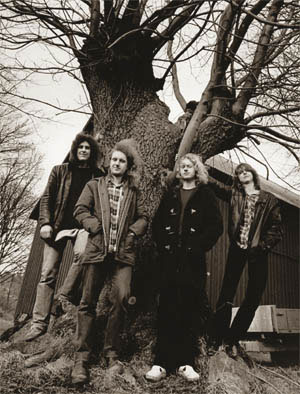
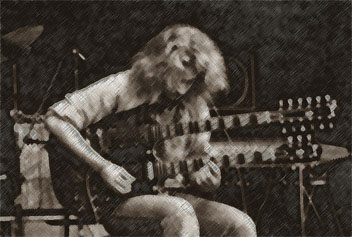
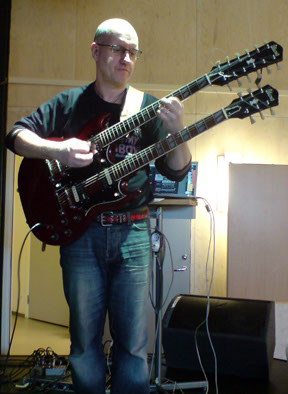
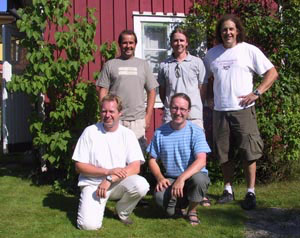
OPUS EST
(1978-1984)
http://www.dprp.net/proghistory/forgotten-sons-opus-est
Opus Est were:
Håkan Nilsson: Vocals, Flute • Leif Olofsson: Keyboards • Anders Olofsson: Drums, Percussion • Kent Olofsson: Guitars • Torbjörn Syrén: Bass
Most of the music for Opus Est was composed by Kent Olofsson, with great help from the other members of the band. The lyrics were mostly written by the drummer Anders Olofsson. Some lyrics are written by old English poets, like many of the lyrics on the LP "Opus I".
The Opus Est Story
Around 1986, I heard an album at a friend's place, with a kind of progressive rock that I liked instantly, from the first seconds into the first song. Powerful, not too complex, a good singer with a personal voice, and stunning musical parts. The band turned out to be from Sweden and was called Opus Est. Weird name, I thought. But different.
The album was called Opus 1. The album sleeve didn't have a lot of info on the band: the musicians' names and the name of the guy who recorded the album. We got used to the idea that this was all we would ever know about this band - just this one amazing album.
In 2002, thanks so the internet, I was able to trace down one of the members of the band: guitarist Kent Olofsson. Of course, he was able to tell me a lot about the band, and also got me in contact with the other musicians. He gave me a copy of the LP (of which he still had a few), and I even got to hear some unreleased music.
The Beginning
The story begins in 1975, with Kent Olofsson getting his first guitar, and playing what he calls "simple rock music" with drummer Anders Olofsson (not related) and bass player Torbjörn Svensson, plus some others. Without a name yet, the three founded the basis for Opus Est in 1977.
In those days, the band played mostly improvised jazz-rock music, influenced by the Mahavishnu Orchestra. For the time being, they called themselves Krishna. Kent has to laugh about this now, saying this was probably influenced by them trying to be like Mahavishnu. During the first two years they moved more and more towards progressive rock with longer compositions and no improvised parts at all. Their main influenced were Genesis, Yes, and ELP.
While on holiday in Spain, in 1979, Kent and Anders met a drunken Dutch guy, who suggested the mane Opus Est for the band. They never knew where he got it from, but they liked it, and adopted it as the band's new name.
The time had come the band needed a singer. They realized that a friend of theirs, Håkan Nilsson, had a great voice. This was something that Håkan himself wasn't very sure about, but he let them talk him into joining the band anyway, in 1978.
Music And Lyrics
The band was working on songs mainly written by Kent. In 1978, the band finished a 23 minute piece of music called The High Mass and a suite in five parts called The Rise And Fall Of The Kingdom Shieldmoor. These songs remained unrecorded professionally, although they sometimes had a tape running during rehearsals. The former, and parts of the latter were recorded this way.
Opus Est in the 80's
Finding a keyboard player proved to be very difficult. The songs they were doing were quite complex. Kent remembers one keyboard player who was trying to play with them, but it was just too difficult for him, too much information, and the short-time band member almost fainted during a rehearsal…
Kent's little brother Leif, who was just 14 at the time, had been taking piano lessons for several years, and the band let him have a go at it. And it worked! In 1979, Opus Est were complete. Leif joined when the band were working on their next opus: Four Metamorphoses Of A Face (a suite in four parts: The Seeing Eye - The God, The Blind Eye, The Nose, and The Mouth). Parts2 and 4 were recorded properly in a studio; the other two exist on a rehearsal tape only.
Two other pieces the band were working on were called Seven Deadly Sins (a suite in eight parts written in 1980, lasting for almost sixty minutes), and Love Dreams, a suite in three parts (1982). Of the latter, only part 1 was recorded properly. The other two parts and all of Seven Deadly Sins were only captured on regular cassettes, recorded while rehearsing. Other song titles include Watchman Of Life, The Touch, and Ode To A Nightingale (a poem by Keats put to music). Of these three, no recordings are known to exist.
During the acoustically driven The Sluggard And The Ants (a part of the Seven Deadly Sins suite), Anders and Håkan played flutes. Hearing those tapes after many years, memories start coming back. Kent remembers the two took flute lessons for a while, only to add some more ingredients into the band's sound.
Anders wrote most of the lyrics. Kent started writing music to poems by W.H. Auden as well, because as he says, he found it so hard to write lyrics that were good enough for the music that he wrote.
1981
When they had a chance to get a new rehearsing place (a bunker which was previously used as a weapon shop), they were told they'd better not disturb thee neighbours. To check how soundproof the bunker was, Anders was told to hit the drums very hard, while the others ran into different directions and listened carefully. Kent ran into the backyard, straight into a drying rack. Ear first! No lasting harm was done, but it took a couple of hours before he had pulled himself together.
For a couple of years now, the band had been a five-piece. In early 1982, bass player Torbjörn decided to leave. Although he enjoyed playing, rehearsing for six days a week was taking too much of his time. Kent took over most of the bass playing. Sometimes he played guitar and bass pedals, sometimes the bass line was played on the keyboards, and sometimes Kent played keyboards when Leif played bass.
Opus 1
Late 1983, Radio Blekinge organized a band competition. Opus Est won the first prize: a mobile studio for a whole week. The band decided t record as much as possible. They recorded in their rehearsal studio, and the mobile studio bus came to their place. Between March 21st and 25th, 1983, they recorded eight tracks. It was early Spring, and when the bus tried to get home, it was completely stuck in the mud, and it took the farming neighbour's tractor to pull it out...
Only after the recordings were finished, the band thought of pressing an LP. So if it wasn't for the band competition, there would not have been any Opus Est material available to the public! And without the LP, of course this CD would not have been here.
Kent, playing his double necked guitar with Opus Est in the 80's
Together with The Bonfires, O What Is That Sound, and The Witnesses, which were recorded a couple of months previously, the band now had ten tracks to put on the album. Two tracks (The Witnesses and Another Time) had to be left off, however, as the vinyl format time limits prevented their inclusion. But what great bonus tracks these make on this CD re-issue!
As it turned out, five of the album tracks were written to W.H. Auden poems. Because it was going to be a private release, they didn't go into the trouble of requesting rights for using the Auden lyrics. For this re-release, however, this has been properly arranged. Also thanks to the internet, it was a lot easier to do than 20 years ago.
A mere 500 copies of the LP wee pressed. Most of them were sold during the first year after its release. Some albums found their ways abroad. It's a pity that an album like this only gets the attention it deserves long after the band ceased to exist.
The End
In December 1983 the band decided to quit, due to lack of success. In Spring 1984, the musicians got together one more time, to record the last couple of songs they had finished: Springtime, Winter, Marie-Claire, and Square The Circle (with lyrics by Magnus Persson, the other two by Anders). The last three songs, The Brocken, Impression Of Summer, and As I Called You were never recorded, as they were never finished.
Kent has long considered his Opus Est adventure as unfinished business. His brother Leif thinks the band would have broken up anyway around that time, because they were working so hard for the band without any kind of success or at least recognition. And as Leif said, he, Torbjörn and Håkan were not the kind of crazy musician that Kent was. He thinks only Anders could have kept up. The others liked to play, but not for seven days a week without getting any response.
Also the excitement of playing live wasn't meant for them Kent thinks the band only played 20 or 25 concerts during the years they existed. They did several concerts in the south of Sweden, and on concert in Helsingør, Denmark. He felt they always played at the wrong places, where no one seemed to like the music very much.
My personal opinion is that the times were not against them, but the country they lived in, as especially in Britain and Holland progressive rock was regaining popularity around the time the album was recorded. Had Opus Est been able to release the album and tour throughout Europe, it's not hard to imagine they would surely have had more success. A real pity, as Radio Blekinge obviously saw the band's talents when they won the band competition that led to the album recordings. It's also ironic to see the number of fine progressive bands Sweden has brought forward, who all started at least a few years after Opus Est decided to quit. It appears Opus Est were ahead of their time.
Kent, playing his double necked guitar with Dame Wiggens in February, 2008
Where Are They Now
Already around 1980, Kent began getting more and more interested in contemporary music, and started to compose n that genre. In 1981, he finished his first big composition, and kept on composing modern and experimental music. After Opus Est, Kent and Anne (whom he met in 1983; they're still together to this day) moved to Lund. Kent began his studies in composition at the Malmö Academy Of Music.
He is composing mostly in the field of contemporary music, and very successfully too. He now is a full-time composer and musician, teaching at the Academy Of Music, doing concerts, writing for other people around the world, releasing solo albums, working in studios and travelling around a lot.
For a couple of years now, he also has a new rock band together called Dame Wiggens, playing rock music that is somewhat hard to label. Rock, a touch of prog, mixed with all kinds of other elements, like Björk, Black Sabbath, Peter Gabriel, and some folk and classical music.
Anders is still a big Yes fan. He lives with his family in Lund, quite close to where Kent lives. He has a small studio in his basement with some drums, synthesizer, keyboard, and a computer, and keeps on performing and composing, helped by his brother Per. He enjoys working like this, but has no ambition to become a professional musician.
Håkan lives in Stockholm now. He stopped singing after Opus Est split up. When Kent looks back, he still believes Håkan had a great voice, and he thinks it's a pity he didn't continue singing. However, Håkan was excited when Kent told him about the plans about the CD re-issue you are holding right now.
Leif has played with several Swedish dance bands for many years. He quit a couple of years ago, ad now lives just outside Karlskrona with his family. He's a very handy man, and has completely rebuilt their old grandmother's house into a wonderful place.
Torbjörn also lives just outside Karlskrona, in Jämjö, with his family. He is still plucking bass strings and he plays in a coverband.
CD
For the CD release of the album, it was clear the LP tracks would be accompanied by the other two tracks recorded around the same time. When Musea heard some of the other stuff, they were more than interested to release a second CD. So be prepared to see an Opus Est CD with nothing but previously unreleased material!
When Kent was asked about the possibilities of an Opus Est reunion, he thought it was a daft idea. But eventually ne changed his mind and he now things it might bw fun! Kent has talked to his former band members and there is a possibility they will re-record some olf songs for the next Opus Est CD. Also Anders thinks it's a great idea to play with his former band members again.
What will happen when they enjoyed making music together again, no one knows. But we can hope…
Jerry van Kooten • Text from CD cover to "Opus I"
OPUS II
In 1983 we had the opportunity to record for a week with a mobile recording studio, a session that resulted in the album "Opus 1". Only one year later the band Opus Est split up. I never expected there would be anything more from us, especially not a new album. But here is "Opus 2"!!!
When Musea Records was planning to re-release "Opus 1" on CD I also sent them some other studio recordings we had made and they suggested we should release that too. And of course we all thought that was a wonderful idea. However, when this came up I couldn't resist thinking it would have been great to include something new! I started looking through material I already had. I thought about trying to write something new for the band and I did of course listen to some old Opus Est songs from old demo tapes.
Opus Est in 2003
There were two studio tracks that were to be included on "Opus 2" that were part of a suite of four parts: "Four Metamorphoses of a Face". Parts 2 and 4 were recorded at the local radio station, Radio Blekinge, in autumn of 1979. Of parts 1 and 3 I only had some old demo recordings from our rehearsals. So, I suggested to the others that we could finally make the whole suite complete! For part 1 of the "Metamorphoses…" there were several demo recordings. At that time, we had tried to do a little more ambitious recording of that part. On part 3 there was only one, quite bad recording that we did during a run-through at a rehearsal in summer 1980.
The end of the 70's was an amazing time in our lives. We spent most of our time playing and listening to music. And we listened a lot! Yes, Genesis, Mahavishnu Orchestra, Bach, Stravinsky... The idea for the "Four Metamorphoses"-suite came from a wooden surrealistic statue of a face that I had made together with artist Peter Jönsson. Then ideas from writers like Freud, Dali and Robert Graves (I, Claudius) and reading books about mythology were the inspiration for the lyrics. And maybe even more important were the influences from paintings by Salvador Dali, René Magritte and Peter Jönsson.
It would have been very nice, and great fun, if we had had time to learn to play these songs together again. But we all realised that this wasn't possible due to work, family and the fact that we live in different cities. So, these new recordings had to be studio recordings where everything was recorded separately.
We were a young band when we did this music, between 14 and 18 years old. But still, this was not at all easy music to work with and it took quite a lot of work to get it all down on paper. I first had to do a simple MIDI-version of the songs to get the form and all tempo changes right. I simply used modern MIDI-instruments to get an idea of how it would sound, and first it didn't really sound like Opus Est at all. But, when we started to add the real instruments into the sessions, it started to sound like the band. I think we have managed to catch the sound and playing style of that Opus Est-period rather well on this recording. The sound is, of course more modern, using all the new recording equipment.
When I had finished the MIDI-demo, I gave Anders the MIDI-files so he could record the drums with these as guide tracks. Anders has a little studio where he recorded the drum tracks. They are the same drums he used on "Opus 1"! I used my mobile equipment to record the bass with Torbjörn. We did that where he rehearses with his cover band in Jämjö. Torbjörn left Opus Est in 1982, so it was really nice to work with him again.
Much of the keyboards are the old Roland string machine we always used, along with the old Yamaha monophonic synthesizer also used on "Opus 1". Both these keyboards are pre-MIDI, so everything had to be played and recorded… no MIDI-editing… But, on this recording, there are also modern, virtual instruments in the computer, of which the most important is the virtual Hammond organ B3. We always wanted that sound of course, but didn't have any organ which sounded at all like that. So finally, on this recording it sounds the way we wanted to!
CD cover to Opus II
In September 2004 I went to Stockholm to record the vocals with Håkan. We had a great day recording the two songs and it was nice to hear that he sounds the same! Just a little darker voice… and no wonder, it has been twenty years since he last recorded anything! I finally added the guitars and did the mixing and editing. It took a very, very long time to record these two songs, simply because it was difficult to find time for us to work with it. But here it is!
I never expected there would be an "Opus 2". So, will there be an "Opus 3"? Well, who knows? We all enjoyed making this recording, and we had some short jam sessions. And there are more Opus Est songs on old demo tapes. And, even more new ideas… So, look out for new a album in a couple of years from now!
Kent Olofsson • Text from CD cover to "Opus II"
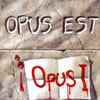
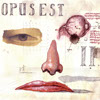
Opus 1, LP released 1983:
The Bonfires
Ventis Rem Tradere
A Walk After Dark
Times
Miss G
O What Is That Sound
If I Could Tell You
Mirrorcle
Springtime
Winter
Square The Circle
Marie-Claire
The Brocken
Opus I, CD released 2003:
Bonfires
Ventis Rem Tradere
A Walk After Dark
Times
Miss Gee
O What Is That Sound
If I Could Tell You
Mirrorcle
Another Time
The Witnesses
No Change Of Place
Håkan Nilsson: Vocals
Leif Olofsson: Synthesizers, Organ, Piano
Anders Olofsson: Drums, Percussion
Kent Olofsson: Bass, Electric and Acoustic Guitars, Vocoder
Music written by Leif Olofsson (1, 2, 5, 6, 9-11) Kent Olofsson (4, 7-11)
Lyrics written by: W.H.Auden (1, 3, 5-7, 9-11) Anders Olofsson (2, 4), Kent Olofsson (8)
All arrangements by OPUS EST
Original cover by Peter Jönsson
Produced by OPUS EST
Engineer Kjell Andersson
Tracks 2, 3, 4, 5, 7, 8, 9 recorded and mixed March 21-25, 1983 in Jämjö with Radio Blekinge Mobile Studio.
Tracks 1,6,10 recorded November 1982 t Radio Blekinge Studio, Karlskrona.
Tracks 1, 3, 6, 7, 10, 11 remastered by Kent olofsson.
Tracks 2, 4, 5, 8, 9 remixed by Kent Olofsson and Anders Olofsson.
Track 11 recorded live, Ronneby November 1982.
Opus II, CD released 2006:
Four Metamorphoses of a Face - suite in four parts (1979-80)
1. The Seeing Eye - The God (recorded 2004)
2. The Blind Eye - The Tear (recorded 1979)
3. The Nose - The Dance Of The Flowers (recorded 2004)
4. The Mouth - The Fallen Virgin (recorded 1979)
Four Songs (1983-84)
Springtime
Winter
Marie-Claire
Square the Circle
Håkan Nilsson: Vocals, Flute (2,4)
Leif Olofsson: Synthesizers, Organ, Piano, Bass (5)
Anders Olofsson: Drums, Percussion
Kent Olofsson: Electric and Acoustic Guitars, Synth Guitar (3), Keyboards (1,3,5,), Bass (6,7,8)
Torbjörn Syrén: Bass (1-4)
Music written by Kent Olofsson (1-4) Kent Olofsson and Leif Olofsson (5-8)
Lyrics by: Kent Olofsson (1-4), Anders Olofsson (5-7), Magnus Persson (8)
All arrangements by OPUS EST
Cover by Peter Jönsson
Tracks 2.4. recorded 1979 at Radio Blekinge Studio, Karlskrona. Engineer Kjell Andersson
Tracks 1.3. recorded and mixed 2004-05 by Kent Olofsson. Drums recorded by Anders Olofsson
Track s 5.6.7.8. recorded and mixed Spring 1984 at Voice Studio, Karlskrona.
Produced by OPUS EST
Other works with Opus Est 1978-84:
(Lyrics written by the drummer Anders Olofsson and English poets.)
The Rise and fall of the kingdom Shieldmoor - suite in five parts 1978
The High Mass 1978
Seven Deadly Sins - suite in eight parts 1980
Love Dreams - suite in three parts 1981